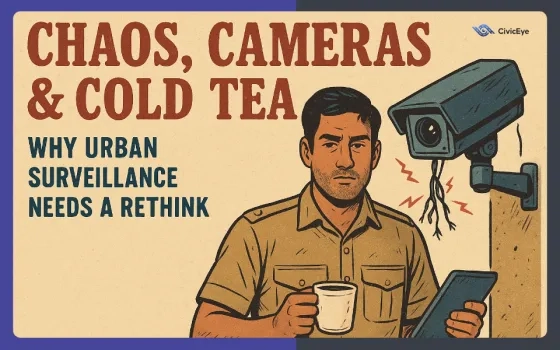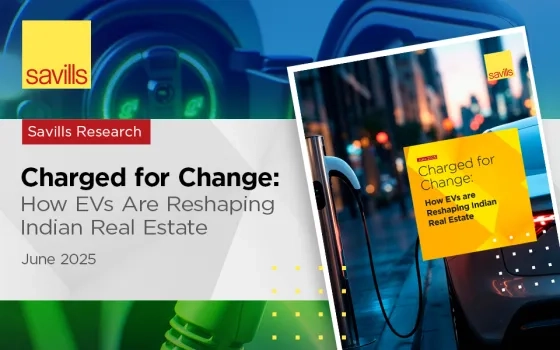
We have all, at some point or another, been caked with mud as a vehicle whooshed by. India is notorious for its potholes, which either give us knee jerks or become reservoirs of murky water. Add to this the incessant honking and the wrong-way driving, and you have a morning ride to the office that leaves you frustrated and wound up for the rest of the day. Covered with grime, and already exhausted, you arrive at your workplace. You head straight for the restroom in an attempt to feel refreshed and ready for the work day ahead. But as soon as you turn on the tap to sprinkle some much-needed clean water on your face, you realize that there has been a water cut. Furious at being denied this basic commodity, you turn to the peon for an explanation, and are told that there has been a leak in the plumbing and the water-supply has been turned off, since the pipes are beeing fixed. You look around at the aged edifice around you, with the horn-blaring world lying outside, and wonder why we ever moved out of the trees.
Now imagine the same morning routine in a hypothetical world, where man-made structures are much more intelligent, and fulfill the purpose they were built for – to make our lives convenient. The pothole that had started to form on your daily route was fixed before it had a chance to turn into a one-foot deep ditch, thanks to the smart sensors that alerted the authorities about its existence. You get a warning about the traffic condition ahead because of the Vehicular Ad-Hoc Network (VANET), and therefore take an alternate route and avoided the jam. You reach the office with a relaxed smile and a crisp and tidy attire. Thanks to the RFID monitoring system, the water pipeline leakage has been fixed over the weekend, and after a refreshing trip the restroom, you are ready to start a productive workday!
The coexistence of humans, buildings and other infrastructures like bridges and roads, and amenities for the convenience of the dwellers, is what makes a city a habitat. From centuries, town planners have been analyzing sites, forecasting how settlements will grow in the future, and designing cities based on these findings, keeping revenue generation and economic conditions in mind. However, as years have passed by and the population has grown tremendously, the old principals of city building do not suffice, and we are facing many issues like congestion, exploitation of land, polluted water bodies, and unhealthy surroundings leading to epidemics. While there are tons of other problems to be addressed, our mangled infrastructure is one of the most exigent ones.
Most of the infrastructures of cities across the world were laid down years ago, according to the requirements of that period. However, a lot of things have changed since then.
In the aftermath of the Mumbai-Goa highway topple, around 14 bodies were recovered, and 28 are still missing, because the bridge gave way, and fell into River Savitri. The reasons for the collapse of the bridge was a wrong audit deeming the bridge fit for traffic, when it wasn’t. The irony is that we witness similar disasters every year and still fail to take preventive measures against them. Government bodies usually neglect early signs of failure of structures, as it is practically impossible, considering the number of highways and roads, to take care of each of them individually.
Smart City Mission Program:
Ironically, the IT centers of the nation, which are at the front line of making innovative solutions for most of the problems we face today, have a portion of the most noticeably awful infrastructure. If you observe IT cities, most of them are designed with inadequate attention to detail. Being stuck on a congested road for a considerable amount of time, waterlogged streets (especially during the rainy seasons), and railroad tracks are typical of these cities. Therefore, it is uplifting to know that the Smart City Mission program has been launched to create 100 savvy urban areas all over India, beginning with 20 cities, with the aggregate expense of Rs 1,770 crore.

We must, however, realize that even though the Smart Mission includes cities like Pune, Chennai, Bhopal, etc., some major cities like Bangalore are not covered in this program. Even the capital city of Maharastra, Mumbai, has not been completely included in the mission, it only includes the region of Navi Mumbai at present. The country needs to realize that an all-encompassing solution is needed to fix the problem of crumbling infrastructure.
Why do we need smart solutions for the infrastructure?
To understand the solution to a problem, we must first understand why the solution is needed in the first place.
While the Smart City Mission is a great step ahead in solving the infrastructural problems we are facing today, it has a few loopholes. Besides not covering some major cities, the clogged roads and drainage systems are also not included under the initiative. Maintenance and reconstruction of roads cause major traffic jams and escalate costs. So, how are we going to find a solution to this? Not only is the construction material compromised but the roads are continuously drilled for laying water pipes or electricity cables, which is another reason for the reduced functionality. We need to address issues of a maturing national foundation of streets and highways where numerous extensions are of the British period. Persistent solutions that solve the issue of gridlock need to be designed.
There is no centralized way of coordinating these activities when we consider the city as a whole unit. Illegal construction blocks the drainage systems causing floods during rains. Lack of water management in addition to leaking water pipes cause water scarcity. Why should we subject people to perform dirty and dangerous jobs of cleaning sewers and drains? In this day and age, can an automated system for these risky jobs not be implemented?
Stacking up all the questions and arriving at a holistic solution leads us to smart technology. It is time that we create innovative and practical solutions for our road problems for the maintenance and repair of our infrastructure. Smart technologies such as IOT, acoustic sensors, and robotics are required to implement holistic solutions to address the maintenance of public utilities. The best part is that the smart technologies proposed are not stand-alone but complementary to projects related to solid waste management, sewage treatment plants, and rainwater harvesting.
Implementation of Smart Solutions for Infrastructure:
- Smart Sensors for Bridges, Highways, and Railways: In India, more than half of the bridges, roads, and highways are in essential need of replacement/repair. The risk of collapse or distortion is very high. Given limited funding, government agencies should prioritize activities but due to many scams and other financially disturbing activities taking place, the authorities are failing to take considerate action. A solution to these issues is the usage of sensors. Advanced IoT sensors that can withstand harsh environment conditions like load, wind, rain and radiation can determine the structural status of a bridge on an ongoing basis and report back to cloud servers in real-time. Data can then be collected & stored for the engineers and data scientists to analyze and predict collapses, and raise an alarm. Based on the analysis, engineers can then prioritize detailed physical checks. By installing sensors in gullies, lampposts, and traffic lights, data can be collected and analyzed to determine which are the critical points on the road that need repairing and cleaning. Predictions of which road structures are susceptible to developing faults can also be carried out to provide timely solutions. Installing sensors along railway tracks (e.g. Kontron which is specially designed for the transportation sector) can inform the rail command center if they need maintenance or are threatened by nearby landslides or flooding. Cameras and network video recorders can be used for platform observation and when installed in railway carriages can also help to monitor wear and tear.

- Acoustic sensors for leak detection in water pipelines: Buried water pipes make up a large part of our public utilities and typically carry huge replacement costs. However, our nation is known for having leaky water pipes and it takes years to get them replaced by government bodies. Estimates from the World Bank suggest that on average up to 20-30% of a utility’s water is lost in water distribution network. Las Vegas Valley Water District Boulevard (LVVWD) have deployed Mueller Water Products’ EchoShore®-TX, a leak detection platform that can find the leaks in the water pipelines. This platform combines proven acoustic leak detection technology with leading-edge AT&T wireless connectivity to create a cost-effective monitoring solution.
- RFID tags, mobile sensors and robotics for water supply and sanitation: Recently, Gurgoan was almost motionless for 12 hours, due to flooded streets. The government had to send a rescue team to clear the jam. The fact that this major corporate hub does not have monsoon-resistant infrastructure goes to show how important it is to adopt new technologies. IoT sensors can be used for maintaining and fixing underground drainage and manholes. Blocked drains are a recurring problem in the rainy season. Inadequate drainage maintenance results in contamination of pure water, and the mixing of wastewater with drinking water can result in infectious diseases. If sewer lid is not closed properly, the chances of accidents are high, and somebody may fall into the drain. Therefore, a solution has been proposed by Mr. Jong-Hoon Kim of Louisiana State University for fixing the drainage and maintaining the pipes including the hydrogen and oil lines. Sensor-based Autonomous Pipeline Monitoring Robotic System (SPRAM) addresses all the hazards faced in the maintenance of all varieties of pipelines and is a novel, cost-effective, scalable, customizable, and free solution. The technology combines low-cost RFID systems, mobile sensors and robotics to provide proactive monitoring of the pipelines. A solution like this, which can help in the automated fixing of pipes, will help us in avoiding the flooded streets that cause widespread distress.
- Smart Traffic Management: These days, everyone is so infatuated with the idea of buying a Smart car. Smart cars enabled with RFID tags along with cameras and sensors on light poles can prevent and minimize accidents. When an accident happens on a highway, all the vehicles moving in that direction can be informed about the approximate accident location and traffic can be diverted towards other safer routes. A smart helmet that can communicate with other drivers and vehicles will be a boon to bikers. A smart helmet is connected to a smartphone, and in the case of a fall or accident, the sensor connected to the helmet can sense the fall quickly and send a message to relatives or family members configured inside the phone app.

The adoption of the smart technology is not very modern. If you had known the town plan of Mohenjo-Daro; you would have applauded their avant-garde implementation of smart solutions to reduce the chaos in the city. The smart solutions of that time were a hierarchal settlement of people, a division of the city into the upper class and lower class, accommodation of public gathering spaces and marketplaces, linkage of streets to the main roads, etc. Similarly, IoT is the recently developing network with the extraordinary potential of resolving infrastructure issues. However, is this network only of devices, or does it include people too? Let us see what exactly a smart infrastructure comprises of, and where do we come into the picture.
Components of the Smart Infrastructure:
- Non-Profit Clusters: Each ‘Smart City’ should engage with its citizens and industries by setting up non-profit consortiums. These consortiums can provide the necessary governance and coordination between various municipal corporations and local communities. Participants could include the municipal corporation, community organizations, citizen portals, NGO’s, industry organizations, and companies. They can provide additional facilities to design and develop original data-driven services to engage public audiences. This consortium should incubate and accelerate early-stage smart city ideas, both local and global, from conception to market introduction. They should also provide advanced engineering, prototyping, and field trials for emerging solutions together with multi-sector collaborators and lead customers. These clusters can encourage participation from the citizens as well. For example, Bihar Deputy Chief Minister Tejaswi Yadav has decided to use instant messaging platform WhatsApp to help construct and repair roads. The citizens take photographs of potholes and send it to the corporation which then uses this to plan road repairs. Using a simple service like WhatsApp, which most of us are familiar with today, can lead to such an innovative solution to our road problems!
- Data Hubs and Advanced Big data analytics centers: To optimize the usage of smart technologies, the government should also set up Big Data hubs that perform advanced big data analytics. Each smart city requires a separate data hub while a centralized data hub is needed for nation-wide data related to highways and bridges. Within each hub, data from all sensors is streamed using an IOT platform, analyzed and then used for planning, monitoring and issuing warning signals. Engineers and Big Data scientists are required to gather data from various sources including roads, bridges, water pipelines and railway tracks. This data, when combined with meteorological and geospatial data, can provide real insights. Various government departments can then use the analysis of data and reports, and municipal corporations to coordinate repair work across different departments. Relevant reports and warnings can be displayed on ‘smart city’ portals. These portals can be ‘to-do’ lists of the authorities so that they can systematically keep fixing the problems that crop up on this list.
- Security: A critical aspect to be considered is how data should be collected and analyzed in a way that benefits the citizens while balancing their need for safety and privacy. Highway data, traffic data, water pipeline, sewage data when aggregated and analyzed, can enhance the life of citizens and prevent road accidents. However, the other extreme of collecting data on an unprecedented scale where cameras and sensors are placed in every crevice of the city raises privacy concerns. For instance, Singapore’s Smart Nation program is likely to affect the lives of every resident in the country. We want solutions to our problems in a smart way, but we don’t want to feel like we are stuck in a futuristic sci-fi movie, where the cameras are always trailed on us and the government is tracking our every move!
Conclusion:
Every nation relies on its energy, water, and transportation infrastructure that provide critical services helps in the growth of the economy of the country. They also ensure safety and enhance public health. Annually, the central government body spends a huge amount on developing new infrastructure and on repairing the existing one. This investment indirectly affects the environmental and economic conditions of local bodies. With the usage of smart infrastructures like traffic monitoring, smart grids, sensors and many that are yet to be invented, countries can increase the efficiency and reduce the costs of the services that are offered to the public.
It’s true that the image we get of anything smart is delicate and tender. However, with the advancement of technology, smart systems these days can withstand any wear and tear and therefore can be incorporated into any project. Smart technologies for cities and highways pose unique IT- infrastructure, networking, and security challenges. Therefore, smart IT-infrastructure is a major step in town planning through which we can create an ambient environment for people to live in. It promises to help us evade the horrible morning rides to the office, and instead make that hypothetic world, where everything goes in our favor, a reality.
References
1. IOT to maintain and build aging road infrastructure
2. IOT in Transportation
3. Leak Detection
4. IOT for smart buildings
5. IOT drives better road maintenance
6. RFID sensor and Robotics for pipeline maintenance

















